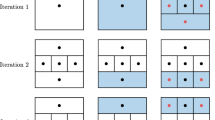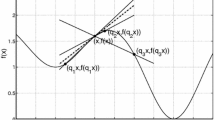Abstract
Most intelligent algorithms can’t predict the existence and possible position of new better solution. This deficiency not only leads to the waste of computing resources, it also affects the efficiency to find the optimal solution. To fix this problem, this paper proposes a new algorithm named extremum inference algorithm. During the iterations, this algorithm uses high efficient algorithms to simultaneously searches for both local maxima and local minima, and then uses a simple principle to infer the existences and possible positions of unknown extremums. By doing this, the extremum inference algorithm can decide if there possibly exists new extremums and search for new extremums in the most possible regions. A strong version of extremum inference algorithm can even provide an approach to estimate searching accuracy, which is a measurement that can help to determine if the global optimal has been found. Our examples demonstrate that the extremum inference algorithm can efficiently solve multimodal problems which are harder to solve than other problems.






Similar content being viewed by others
References
Delice, Y., Kızılkaya Aydoğan, E., Özcan, U., et al. (2017). A modified particle swarm optimization algorithm to mixed-model two-sided assembly line balancing. Journal of Intelligent Manufacturing. https://doi.org/10.1007/s10845-014-0959-7.
Ding, S., Li, H., Su, C., et al. (2013). Evolutionary artificial neural networks: a review. Artificial Intelligence Review. https://doi.org/10.1007/s10462-011-9270-6.
Wei, L., Zhang, Z., Zhang, D., et al. (2018). A simulated annealing algorithm for the capacitated vehicle routing problem with two-dimensional loading constraints. European Journal of Operational Research. https://doi.org/10.1016/j.ejor.2017.08.035.
Karaboga, D., Gorkemli, B., Ozturk, C., et al. (2014). A comprehensive survey: artificial bee colony (ABC) algorithm and applications. Artificial Intelligence Review. https://doi.org/10.1007/s10462-012-9328-0.
Fister, I., Fister, I., Yang, X., et al. (2013). A comprehensive review of firefly algorithms. Swarm and Evolutionary Computation. https://doi.org/10.1016/j.swevo.2013.06.001.
Mirjalili, S., & Lewis, A. (2014). Adaptive gbest-guided gravitational search algorithm. Neural Computing and Applications. https://doi.org/10.1007/s00521-014-1640-y.
Yang, X. S., & He, X. (2013). Bat algorithm: literature review and applications. International Journal of Bio-Inspired Computation. https://doi.org/10.1504/IJBIC.2013.055093.
Liu, J., & Lampinen, J. (2005). A fuzzy adaptive differential evolution algorithm. Soft Computing. https://doi.org/10.1007/s00500-004-0363-x.
Yang, X., Cui, Z., Xiao, R., et al. (2013). Swarm intelligence and bio-inspired computation: Theory and applications. London: Elsevier Science & Technology Books.
Yuan, K., Ling, Q., & Yin, W. (2016). On the convergence of decentralized gradient descent. SIAM Journal on Optimization. https://doi.org/10.1137/130943170.
Klein, S., Pluim, J. P. W., Staring, M., et al. (2009). Adaptive stochastic gradient descent optimisation for image registration. International Journal of Computer Vision. https://doi.org/10.1007/s11263-008-0168-y.
Beck, A., & Tetruashvili, L. (2013). On the convergence of block coordinate descent type methods. SIAM Journal on Optimization. https://doi.org/10.1137/120887679.
Dai, Y., & Kou, C. (2013). A nonlinear conjugate gradient algorithm with an optimal property and an improved Wolfe line search. SIAM Journal on Optimization. https://doi.org/10.1137/100813026.
Qiao, Y., van Lew, B., Lelieveldt, B. P. F., et al. (2016). Fast automatic step size estimation for gradient descent optimization of image registration. IEEE Transactions on Medical Imaging. https://doi.org/10.1109/TMI.2015.2476354.
Roberge, V., Tarbouchi, M., & Labonte, G. (2013). Comparison of parallel genetic algorithm and particle swarm optimization for real-time UAV path planning. IEEE Transactions on Industrial Informatics. https://doi.org/10.1109/TII.2012.2198665.
Gülcü, Ş., & Kodaz, H. (2015). A novel parallel multi-swarm algorithm based on comprehensive learning particle swarm optimization. Engineering Applications of Artificial Intelligence. https://doi.org/10.1016/j.engappai.2015.06.013.
Czerniak, J. M., & Zarzycki, H. (2017). Artificial acari optimization as a new strategy for global optimization of multimodal functions. Journal of Computational Science. https://doi.org/10.1016/j.jocs.2017.05.028.
Birgin, E. G. (2001). A spectral conjugate gradient method for unconstrained optimization. Applied Mathematics and Optimization. https://doi.org/10.1007/s00245-001-0003-0.
Yuan, G., Wei, Z., & Lu, X. (2017). Global convergence of BFGS and PRP methods under a modified weak Wolfe–Powell line search. Applied Mathematical Modelling. https://doi.org/10.1016/j.apm.2017.02.008.
Valdez, F., Melin, P., & Castillo, O. (2014). Toolbox for bio-inspired optimization of mathematical functions. Computer Applications in Engineering Education. https://doi.org/10.1002/cae.20523.
Singh, G. P., & Singh, A. (2014). Comparative study of Krill Herd, firefly and cuckoo search algorithms for unimodal and multimodal optimization. International Journal of Intelligent Systems and Applications. https://doi.org/10.5815/ijisa.2014.03.04.
Campana, E. F., Diez, M., Iemma, U., et al. (2016). Derivative-free global ship design optimization using global/local hybridization of the DIRECT algorithm. Optimization and Engineering. https://doi.org/10.1007/s11081-015-9303-0.
Author information
Authors and Affiliations
Corresponding author
Rights and permissions
About this article
Cite this article
Zhang, H., Kang, X., Zhang, R. et al. Extremum Inference Algorithm: A Clever Optimization Algorithm. Wireless Pers Commun 102, 1617–1632 (2018). https://doi.org/10.1007/s11277-017-5219-7
Published:
Issue Date:
DOI: https://doi.org/10.1007/s11277-017-5219-7




